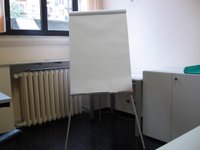 Community Language Learning (also called Counseling Language Learning) was created by Charles A Curran, a Jesuit priest and professor of psychology, and Paul La Forge. Inspired by the humanistic psychology of Carl Rogers, it aimed to remove the anxiety from learning by changing the relationship between the teacher and student. In CLL, that relationship the “teacher” – who is known not as the teacher but as the “knower”, the one who knows the language – is seen as being in the same relationship to the student as the counsellor is to a client : the client has a “problem” (in this case not knowing the language) which is currently creating confusion and causing problems. The counsellor’s role is not to tell the client what to do, but to help him or her explore and resolve the problem while retaining personal autonomy.
Community Language Learning (also called Counseling Language Learning) was created by Charles A Curran, a Jesuit priest and professor of psychology, and Paul La Forge. Inspired by the humanistic psychology of Carl Rogers, it aimed to remove the anxiety from learning by changing the relationship between the teacher and student. In CLL, that relationship the “teacher” – who is known not as the teacher but as the “knower”, the one who knows the language – is seen as being in the same relationship to the student as the counsellor is to a client : the client has a “problem” (in this case not knowing the language) which is currently creating confusion and causing problems. The counsellor’s role is not to tell the client what to do, but to help him or her explore and resolve the problem while retaining personal autonomy.In CLL, it is therefore the learner who to a great extent decides what is happening. The approach (at least in the beginning stages) is based around a set technique, within which the students are free to determine content. A typical CLL lesson using this technique would have the following stages :
Stage One – Investment : The students sit in a circle with a tape recorder in the middle. The knower is outside the circle. The first student who wants to say something calls the knower over, and quietly says what she wants to say in his or her own language. The knower repeats this in English, using a non-threatening and encouraging tone of voice. The student has the chance to repeat and practise the utterance, with help if necessary from the knower, before finally recording it on the tape. Another student who wishes to reply then repeats the process. This continues until a full conversation has been recorded – when I’ve used the approach we’ve probably spent about twenty to thirty minutes on this phase, though Earl Stevick (1) suggests that it should be limited to ten. He however was using it with a much larger group than I was - he describes a class of twelve whereas I only had three. In his situation each individual would obviously have been involved in the conversation relatively infrequently and a longer session could have led to a demotivating drop in pace.
Stage Two – Analysis : Between one session and the next (or possibly immediately, on the board) the knower transcribes the complete conversation, and the students then listen again to the tape while following the transcript. They then have the chance to ask for any explanation they want, and if they wish, to ask for practice activities on specific points.
Stage Three – Reflection : The students then have the chance to reflect on the whole experience, and to decide how useful it was, if they could have done things differently and so on. Again, the knower’s job is not to “tell them where they went wrong” but to help them discover for themselves how they could have made the session maximally useful.
The learner is seen as passing through five psychological stages as learning progresses, which Curran likens to progressing from childhood to adulthood :
1. Birth : the learners know nothing of the target language, and are completely dependent on the knower for everything they want to say.
2. Self : the learners start to get an idea of how the language works and to use it for themselves, but still seek the knower’s help. They may, for instance tell the knower what they want to say directly in the target language, looking to the knower only for confirmation or correction.
3. Separate Existence : they start to use the language without referring to the knower, and may even be resentful of his/her attempts to help.
4. Adolescence : learners continue to express themselves independently, but may be aware of gaps in their knowledge, and start to turn back to the knower.
5. Independence : learners can continue their learning independently. They no longer need the knower, and may start to act as counsellors for less advanced students.
Alan Maley (2) criticises CLL as being one of several humanistic approaches to emerge in the 70s which evolved separately from mainstream language teaching and which all imposed their own “fairly rigidly-prescriptive” method. Not everyone agrees - Earl Stevick (3) suggests that while there may have been a certain resistance to adaptation of the method at the outset "the followers of Curran were never inhibited from devising their own techniques withing the Counseling-Learning Approach." Stevick himself (1) talks of incorporating Suggestopaedic concert readings (4) into his CLL lessons, and virtually any writer on the method will describe a "typical" lesson as including features which are slightly different from the outline Ive given here.
If a certain amount of flexibility is possible, is it also possible to incorporate CLL into your courses as just one technique amongst many which you use ? The answer to this will probably depend on your teaching situation :
- At complete beginner level, the group needs to be fairly small or the students spend the whole time just waiting for others to record their utterances. Jo Bertrand (5) discusses the possibility of dividing large classes into groups and having them work simultaneously, but it is hard to see how this would be possible (without the presence of a second or third knower in the class) until the students have reached at least the “separate existence” stage.
- If you teach students whose language you don’t understand, again the method will not be possible at beginner level.
- How much time do you have to spend? CLL isn’t something that can be fitted into a lesson as a “filler”. Each session will involve at least an hour’s work, though this might be split between two lessons. And in my experience, it’s not something that works well the first time you do it – or for that matter the second or the third. It’s a method which involves the students in making their own choices about how to learn, evaluating their success, trying out something different, reflecting on that … and so on. It’s not until they’ve been through several sessions that things really start to work.
And obviously, if you want to use the method as it was intended to be used, you will need some knowledge of counselling. While there is nothing in the conversation stage of the lesson that precludes it being used as a technique in a far more teacher-guided class, bear in mind that if you intervene in a more "authoritative" way without being asked for help – for instance, by deciding who will speak and what they’ll talk about in stage one, or by giving unsolicited explanations and deciding what to practice in stage two – you are no longer using CLL.
In Part Two of this article, I’ll describe how I used CLL as a component of one particular course, what it meant to adopt a counselling rather than a teaching role, and the stages the learners went through as they “learnt how to learn”
Notes
1. Earl Stevick, A Way and Ways, Heinle and Heinle 1980. (Probably the best introduction to CLL, it contains two sections describing in detail a CLL course and the role of the teacher.)
2. Alan Maley : Community Language Learning
3. Earl Stevick, Humanism in Language Teaching, OUP 1990
4. You can hear Sue talking about both CLL and Suggestopaedia, as well as TPR, in the podcast interview Integrating Various Methodologies into the Classroom on ESL Teacher Talk
5. Jo Bertrand : Community Language Learning
Photo provided under Creative Commons Licence by SusanNYC via flickr

















+Price+and+Review.jpeg)
.jpeg)

.jpeg)
